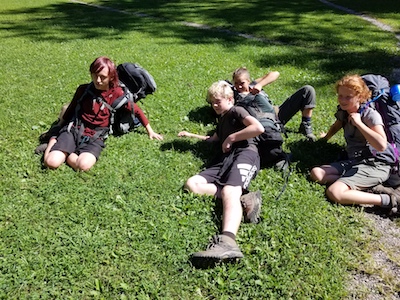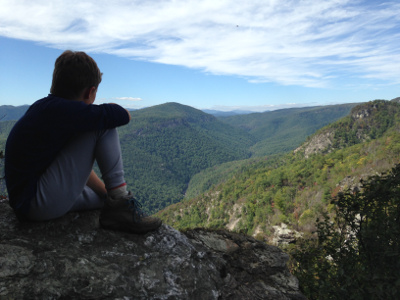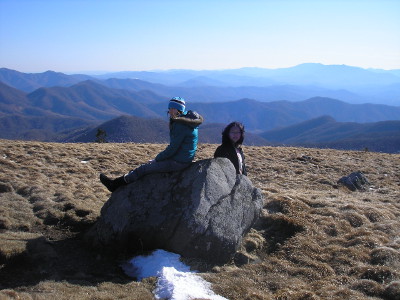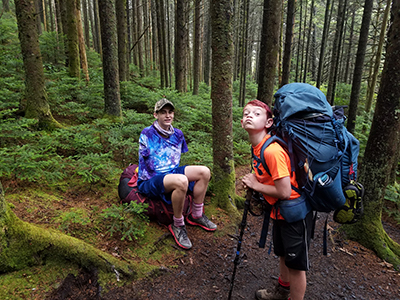Social and Emotional Learning through Outdoor Trips

“Ahhhhh, George*, stop being such an idiot,” the rain soaked, 13 year old girl in front of me screamed as she threw down her heavy back. George halted, mumbling the last few words of the song he was singing loudly only a second before. The rest of the group stopped mid-step. They stared at Stephanie and then looked at me, unsure of what to do. Stephanie was not a quiet student, but she tended to keep her cool around others. When she did get upset, it was usually for an obvious reason, but this outburst was a mystery. She began to shout, curse words punctuating her insults at George, who now looked shellshocked. I asked the other trip leaders to move the group down the trail, leaving Stephanie and me to get some much needed space. Once they were out of earshot, I turned back toward Stephanie. Despite the rain, I could still see the large tears rolling down her cheeks.
Heavy Pack and Heavy Feelings
 For middle schoolers, backpacking trips are hard. It’s not just the heavy pack or the occasional downpour of rain that makes them difficult. These challenges, along with the cold nights, iodinated water, and rehydrated food, are the struggles they can count on. Trip leaders can prepare their hikers beforehand so they know just what to expect. Although difficult, these obstacles rarely lead to a student throwing down their pack and screaming in frustration. An outburst like usually comes from the unexpected challenge that comes with being out in the wilderness: facing one’s emotions!
For middle schoolers, backpacking trips are hard. It’s not just the heavy pack or the occasional downpour of rain that makes them difficult. These challenges, along with the cold nights, iodinated water, and rehydrated food, are the struggles they can count on. Trip leaders can prepare their hikers beforehand so they know just what to expect. Although difficult, these obstacles rarely lead to a student throwing down their pack and screaming in frustration. An outburst like usually comes from the unexpected challenge that comes with being out in the wilderness: facing one’s emotions!
Every year, in the last week of September, Arthur Morgan School takes students on six day backpacking trips. They hike over Roan Mountain on the Appalachian Trail or in the shadow of Cold Mountain in the Shining Rock Wilderness. Sometimes they visit Linville Gorge. No matter which trip students go on, they always face physical and emotional challenges that push them to grow, not only as individuals, but as members of the school community.
Hitting the Emotional Wall
In Stephanie’s case, this was her moment. Stephanie was student who liked to appear in control. She was always willing to help out with chores, was a strong hiker, and a reliable source of positivity and optimism on the trail. However, after four days of roughing it and being stuck with her fellow hikers, she had had enough. Through large sobs, Stephanie vented about every difficult moment she had experienced on the trail that week; every time she got annoyed with another student for being selfish or inconsiderate; the stress she felt when the group got lost the day before; the weariness of not knowing how much further she had to go after a poor night’s sleep. George came up briefly in her frustrations. He hadn’t stop singing when she asked him to, but it was now obvious he was just the final straw on a weight Stephanie had been carrying for days. She was tired, sore, and missing home.

I stood still, quietly listening to Stephanie spew out her frustrations and tried to keep myself from smiling. I wasn’t enjoying the fact that Stephanie was in pain, but truthfully I live for these emotionally instructive moments. For 17 years, I have lead students on backpacking trips, and on almost every trip, there is a moment when a student hits their wall. They cry, they yell, they curse, they refuse to hike. They come face to face with their limitations, both physical and emotional. And in it’s in that moment that they grow the most.
Learn more about AMS’s outdoor program!
Getting Rid of the Emotional Mask
Middle schoolers often put up a facade. Each day when they walk into school, they wear an emotional mask that hides their feelings from teachers and friends. They act like they are impenetrable, unable to be hurt. It protects them from bullying and teasing. Thanks to AMS’s holistic culture, many students learn to lose their mask and be themselves, however the transition takes time. The social and emotional learning AMS offers is not automatic. Many students come from public school and are mistrustful of a community which says it’s safe to be themselves. They heard the rhetoric before and it was proven false. They don’t want to risk putting themselves out there and getting hurt again. So for the first few weeks of every school year, new students tend to walk and talk delicately around their peers. Then comes the six days backpacking trip!
 After a few minutes, Stephanie calmed down. I told her I understood and that her frustrations were valid. I smiled at her and she smiled back. A minute later, she was walking down the trail with her pack, her fellow students happily greeting her back into the group. For the rest of the day, the entire group was in better spirits. It was as if Stephanie’s outburst had been a cleansing for everyone on the trip. Through her, they were able to see that all the anger, fear, and sadness they had been silently experiencing was valid.
After a few minutes, Stephanie calmed down. I told her I understood and that her frustrations were valid. I smiled at her and she smiled back. A minute later, she was walking down the trail with her pack, her fellow students happily greeting her back into the group. For the rest of the day, the entire group was in better spirits. It was as if Stephanie’s outburst had been a cleansing for everyone on the trip. Through her, they were able to see that all the anger, fear, and sadness they had been silently experiencing was valid.
Spreading the Emotional Learning
That night around a campfire at the shelter, Stephanie and George joked with one another. I think I even heard them sing together for a moment. Newer students watched as forgiveness and acceptance were offered freely.
After the trips, there is not an immediate change in the school’s culture, but important steps were taken. Not every student, not even most of them, had an emotional breakthrough while on the trip, but chances are, they witnessed one. Through example, they saw a friend struggle and still be accepted. They learn that it is safe to be themselves and let their emotions show. As the year continues, they will do the same.
-By Nicholas Maldonado
*The names of students have been changed to protect the innocent.
